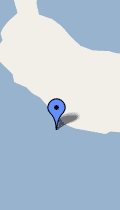
Heron Neck Light
Heron Neck Light
Nearby town:
Vinalhavem, ME
Established:
1854
Year Light First Lit:
1854
Lighthouse Automated:
1982
Lighthouse Operational:
Yes, active aid to navigation
Tower Height: 30 feet
Present Optics:
300 MM
Accessibility:
Viewed by boat/boat charter
Open to public:
No, closed to public
Heron Neck Light - located in Penobscot Bay, on Green Island, at the east entrance to Hurricane Sound
Heron Neck Light (+44° 1' 30.00", -68° 51' 44.00") is located in Penobscot Bay, on Green Island, at the east entrance to Hurricane Sound. It is an active U.S. Coast Guard aid to navigation with a characteristic of a fixed red with a white sector. Its fog signal sounds 1 blast every 30 seconds. It was built to help guide mariners into Vinalhaven’s Carver’s Harbor, a center for fishing and lobster boats.
The 30-foot brick cylindrical lighthouse was built in 1854 and was attached to a brick dwelling. A fifth-order Fresnel lens was installed. Originally, the station was outfitted with a fog bell, but that was later replaced by a siren.
Legend has it that in the early 1900s, Keeper Captain Levi Farnham trained his Newfoundland Nemo to bark loudly whenever it heard boats or ships blowing their fog horns. In the event of fog, Nemo would walk out to the end of the neck to wait and listen for approaching vessels, and then bark his head off to warn them. Nemo was succeeded by another dog, Rover, which provided the same service. These two pets were coined, “the fog dogs.” In fair weather, grateful mariners were known to throw treats to the dogs as they sailed past.
The original keeper’s dwelling was torn down and a wooden house was built in its place in 1895. The original tower was reattached to the new dwelling. An oil house was added in 1903, and still stands today. A boathouse and slip were added in 1904.
The keepers kept two large cisterns in the dwelling basement to store their fresh water.
The last civilian keeper was Andrew Bennett of Vinalhaven and he served at the station for over 20 years. The light was automated in 1982, and a new 300mm lens took the place of the old Fresnel lens.
In 1989, the keeper’s house was badly damaged by an electrical fire. The tower was saved by a Halon fire suppression system. The Coast Guard proposed demolishing the remains, but citizens opposed the plan and began a discussion of alternative courses of action. The Island Institute of Rockland offered to assume title to the station and to restore and maintain the keeper’s dwelling.
It was this Heron Neck project that inspired the Island Institute to found the Maine Lights Program, a program which enabled Maine lighthouses to be turned over to responsible parties, such as non-profits, educational institutions, or government entities. Many Maine lighthouses have benefited from this program.
Heron Neck’s lighthouse is not open to the public and is best viewed from the water. No regularly scheduled cruises pass by the light, but many lighthouse watchers choose to privately charter a boat.
The station is listed on the National Register of Historic Places.






